Glaciochemistry of Cave Ice: Paradana and Snežna Caves, Slovenia
Abstract
1. Introduction
2. Materials and Methods
2.1. Field Area and Sample Collection
2.2. Sample Processing and Analysis
3. Results
4. Discussion
5. Conclusions
Author Contributions
Funding
Acknowledgments
Conflicts of Interest
Appendix A
| USGS | SPEX | % Difference | |
|---|---|---|---|
| F | −4.50 | 3.86 | 0.2–3 |
| Cl | −1.99 | 1.26 | 0.2–0.9 |
| Br | n/a | −0.21 | 1.4–4 |
| N-NO3 | n/a | −6.88 | 1.3–5 |
| SO4 | 4.38 | 0.19 | 1–6.4 |
| Na | −6.75 | 1.33 | 3.9–5.4 |
| K | −5.00 | 4.09 | 3.0–3.9 |
| Mg | −5.02 | −8.70 | 2.1–9.5 |
| Ca | 1.02 | −4.89 | 2.7–8.8 |
References
- Perşoiu, A.; Lauritzen, S.-E. (Eds.) ICE Caves; Elsevier: Amsterdam, The Netherlands, 2018; ISBN 978-0-12-811739-2. [Google Scholar]
- Kern, Z.; Persiou, A. Cave ice—The imminent loss of untapped mid-latitude cryospheric palæoenvironmental archives. Quat. Sci. Rev. 2013, 67, 1–7. [Google Scholar] [CrossRef]
- Perşoiu, A.; Onac, B.P. Ice in Caves. In Encyclopedia of Caves; White, W.B., Culver, D.C., Eds.; Academic Press: Waltham, MA, USA, 2012; pp. 399–404. ISBN 978-0-12-383832-2. [Google Scholar]
- Gómez-Lende, M.; Serrano, E.; Bordehore, L.J.; Sandoval, S. The role of GPR techniques in determining cave properties: Peña castil ice cave, Picos de Europa. Earth Surf. Proc. Landf. 2016, 41, 2177–2190. [Google Scholar] [CrossRef]
- Dobinski, W. Permafrost. Earth Sci. Rev. 2011, 108, 158–169. [Google Scholar] [CrossRef]
- Luetscher, M.; Jeannin, P.-Y.; Haeberli, W. Ice caves as an indicator of winter climate evolution: A case study from the Jura Mountains. Holocene 2005, 15, 982–993. [Google Scholar] [CrossRef]
- Colucci, R.R.; Fontana, D.; Forte, E.; Potleca, M.; Gugliemin, M. Response of ice caves to weather extremes in the southeastern Alps, Europe. Geomorphology 2016, 261, 1–11. [Google Scholar] [CrossRef]
- Perşoiu, A.; Onac, B.P.; Wynn, J.; Bojar, A.-V.; Holmgren, K. Stable isotope behavior during cave ice formation by water freezing in Scarisoara Ice Cave, Romania. J. Geophys. Res. 2011, 116, 1–8. [Google Scholar] [CrossRef]
- Kern, Z.; Fórizs, I.; Pavuza, R.; Molnár, M.; Nagy, B. Isotope hydrological studies of the perennial ice deposit of Saarhalle, Mammuthöle, Dachstein Mts., Austria. Cryosphere 2011, 5, 291–298. [Google Scholar] [CrossRef]
- Kern, Z.; Széles, E.; Horvatinčić, N.; Fórizs, I.; Bočić, N.; Nagy, B. Glaciochemical investigations of the ice deposit of Vukušić Ice Cave, Velebit Mountain, Croatia. Cryosphere 2011, 5, 485–494. [Google Scholar] [CrossRef]
- Citterio, M.; Turri, S.; Bini, A.; Maggi, V. Observed trends in the chemical composition, δ18O and crystal sizes vs. depth in the first ice core from the LoLc 1650 “Abisso sul Marine dell’Alto Bregai” ice cave (Lecco, Italy). Theor. Appl. Karstol. 2004, 17, 45–50. [Google Scholar]
- Citterio, M.; Turri, S.; Bini, A.; Maggi, V.; Pelfini, M.; Pini, R.; Ravazzi, C.; Santilli, M.; Stenni, B.; Udisti, R. Multidisciplinary approach to the study of the Lo Lc 1650 “Abisso sul Margin dell’Alto Bregai” ice cave (Lecco, Italy). Theor. Appl. Karstol. 2004, 17, 27–44. [Google Scholar]
- Clausen, H.B.; Hansen, S.B.; Laresen, L.B.; Siggaard-Andersen, M.L.; Sjolte, J.; Lundholm, S.C.; Vrana, K.; Baker, J. Continental ice body in Dobsina Ice Cave (Slovakia)—Part II—Results of chemical and isotopic study. In Proceedings of the 2nd International Workshop on Ice Caves, Demänovská Dolina, Slovak, 8–12 May 2006; Zelinka, J., Ed.; Knižné Centrum: Žilina, Slovakia, 2007; pp. 29–37. [Google Scholar]
- Munroe, J.S.; O’Keefe, S.S.; Gorin, A.L. Chronology, stable isotopes, and glaciochemistry of perennial ice in Strickler Cavern, Idaho, USA. GSA Bull. 2018, 130, 175–192. [Google Scholar] [CrossRef]
- Mihevc, A. Ice caves in Slovenia. In ICE Caves; Perşoiu, A., Lauritzen, S.-E., Eds.; Elsevier: Amsterdam, The Netherlands, 2018; pp. 691–703. [Google Scholar] [CrossRef]
- Mihevc, A. Distribution and characteristics of ice caves in Slovenia. In Proceedings of the 3rd International Workshop on Ice Caves, Berchtesgaden, Germany, 11 November 2007; Turri, S., Ed.; State University: Perm, Russia, 2008; pp. 61–64. [Google Scholar]
- Hauselmann, P.; Mihevc, A.; Pruner, P.; Horáček, I.; Čermák, S.; Hercman, H.; Sahy, D.; Fiebig, M.; Zupan Hajna, N.; Bosak, P. Snežna jama (Slovenia): Interdisciplinary dating of cave sediments and implication for landscape evolution. Geomorphology 2015, 247, 10–24. [Google Scholar] [CrossRef] [PubMed]
- Welch, K.A.; Lyons, W.B.; Graham, E.; Neumann, K.; Thomas, J.M.; Mikesell, D. Determination of major element chemistry in terrestrial waters from Antarctica by ion chromatography. J. Chromatogr. A 1996, 739, 257–265. [Google Scholar] [CrossRef]
- Welch, K.A.; Lyons, W.B.; Whisner, C.; Gardner, C.B.; Gooseff, M.N.; McKnight, D.M.; Priscu, J.C. Spatial variations in the geochemistry of glacial meltwater streams in the Taylor Valley, Antarctica. Antarc. Sci. 2010, 22, 662–672. [Google Scholar] [CrossRef]
- Vreča, P.; Krajcar Bronić, I.; Leis, A.; Demšar, M. Isotopic composition of precipitation at the station Ljubljana (Reaktor), Slovenia-period 2007–2010. Geologija 2014, 57, 217–230. [Google Scholar] [CrossRef]
- Vreča, P.; Krajcar Bronić, I.; Leis, A. Isotopic composition of precipitation in Portorož (Slovenia). Geologija 2011, 54, 129–138. [Google Scholar] [CrossRef]
- Vreča, P.; Brenčič, M.; Leis, A. Comparison of monthly and daily isotopic composition of precipitation in the coastal area of Slovenia. Isotopes Environ. Health Stud. 2007, 43, 307–321. [Google Scholar] [CrossRef]
- Craig, H. Isotopic variations in meteoric waters. Science 1961, 133, 1702–1703. [Google Scholar] [CrossRef]
- Ogrinc, N.; Kanduč, T.; Stichler, W.; Vreča, P. Spatial and seasonal variations in δ18O and δD values in the River Sava in Slovenia. J. Hydrol. 2008, 359, 303–312. [Google Scholar] [CrossRef]
- Yonge, C.J.; MacDonald, W.D. The potential of perennial cave ice in isotope palaeoclimatology. Boreas 1999, 28, 357–362. [Google Scholar] [CrossRef]
- Muri, G. Atmospheric deposition chemistry in a subalpine area of the Julian Alps, North-West Slovenia. J. Limnol. 2013, 72, 291–300. [Google Scholar] [CrossRef]
- Huang, U.; Fairchild, I.J.; Borsato, A.; Frisia, S.; Cassidy, N.J.; McDermott, F.; Hawkesworth, C.J. Seasonal variations in Sr, Mg, and P in modern speleothems (Grotta di Ernesto, Italy). Chem. Geol. 2001, 175, 429–448. [Google Scholar] [CrossRef]
- Žák, K.; Onac, B.P.; Kadebskaya, O.I.; Filippi, M.; Dublyansky, Y.; Luetscher, M. Cryogenic mineral formation in caves. In ICE Caves; Elsevier: Amsterdam, The Netherlands, 2018; pp. 123–162. [Google Scholar] [CrossRef]
- Vreča, P.; Malenšek, N. Slovenian network of isotopes in precipitation (SLONIP)—A review of activities in the period 1981–2015. Geologija 2016, 59, 67–84. [Google Scholar] [CrossRef]
- Perşoiu, A.; Pazdur, A. Ice genesis and its long-term mass balance and dynamics in Scarisoara Ice Cave, Romania. Cryosphere 2011, 5, 45–53. [Google Scholar] [CrossRef]
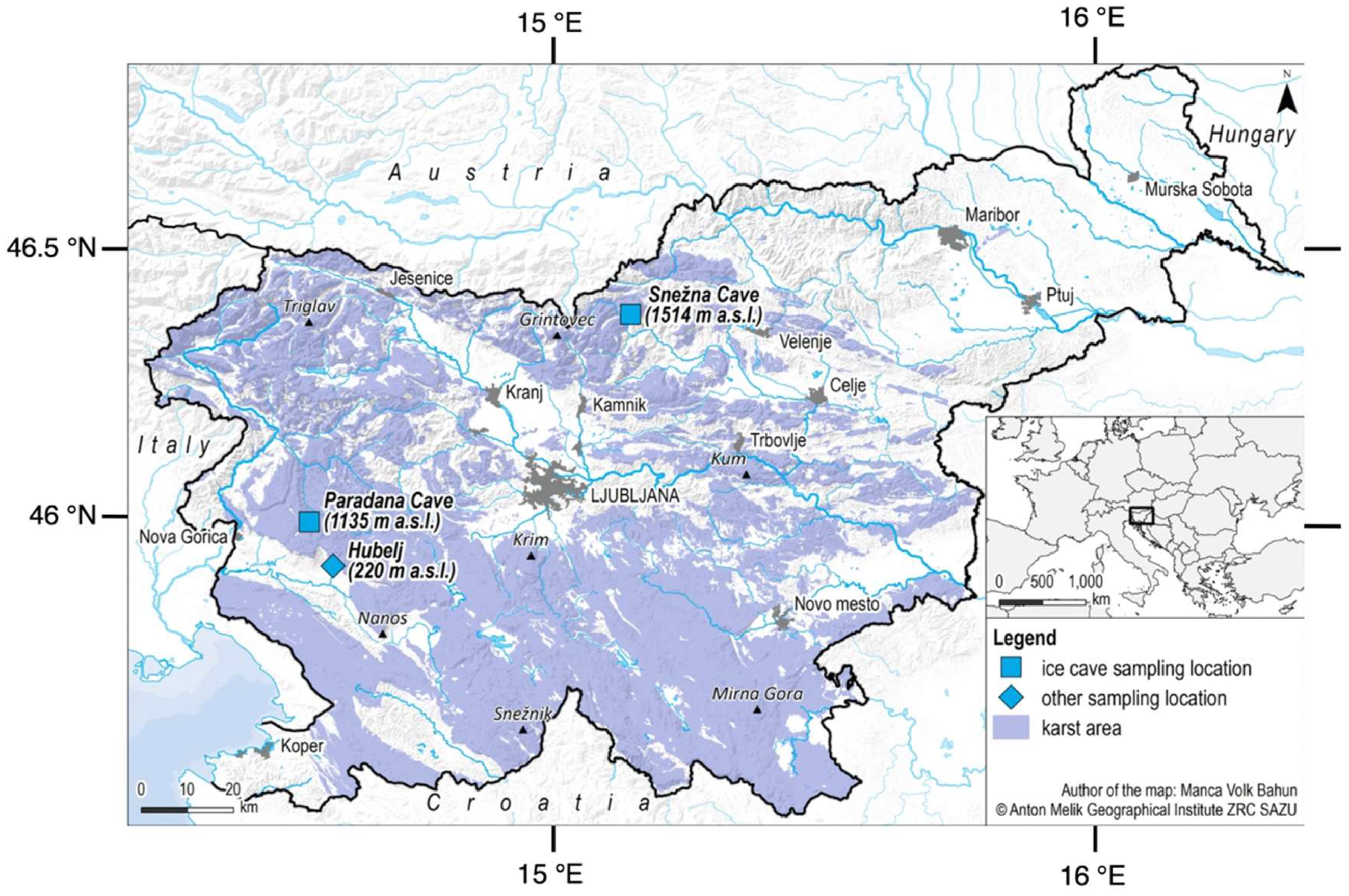

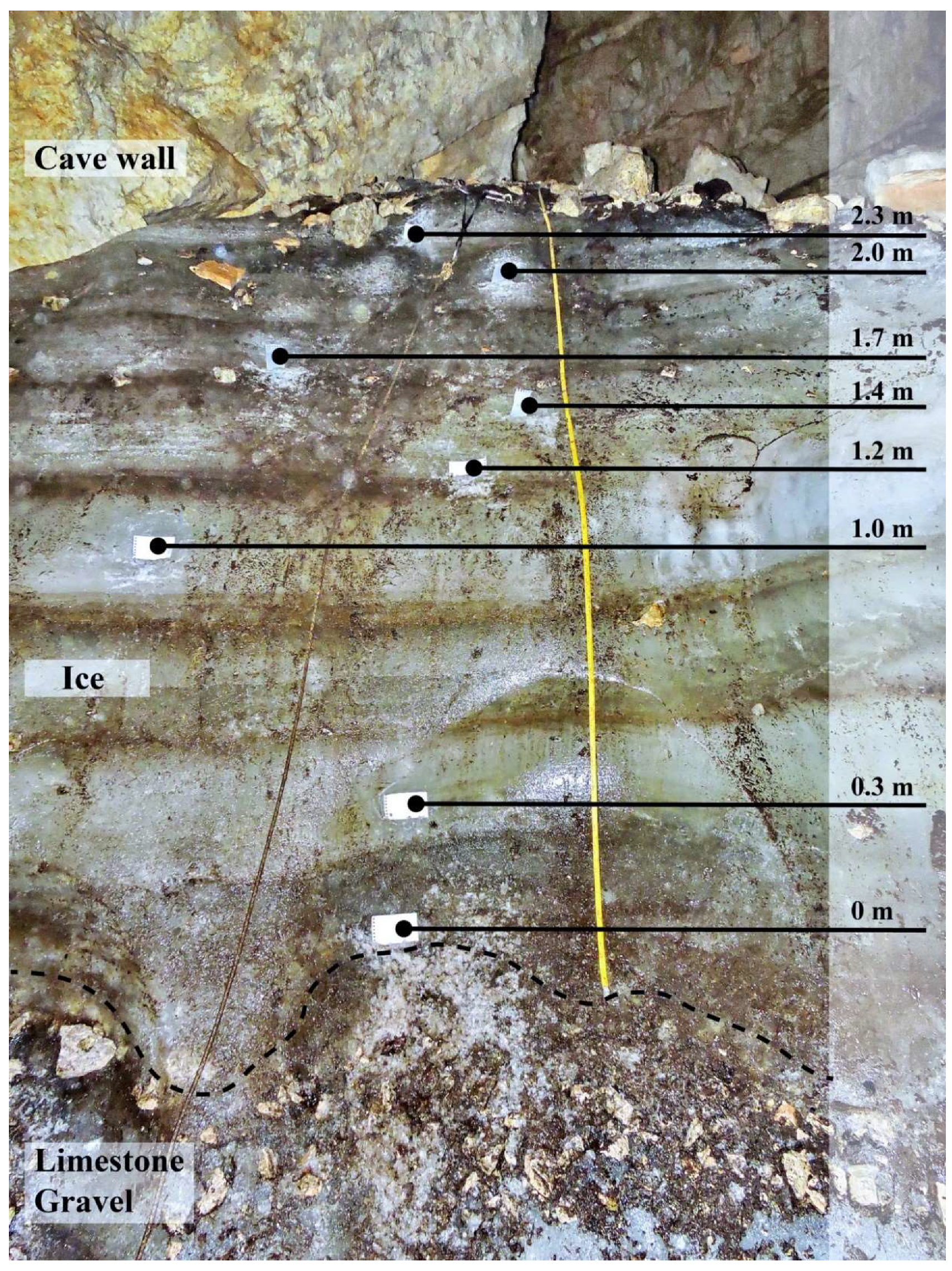
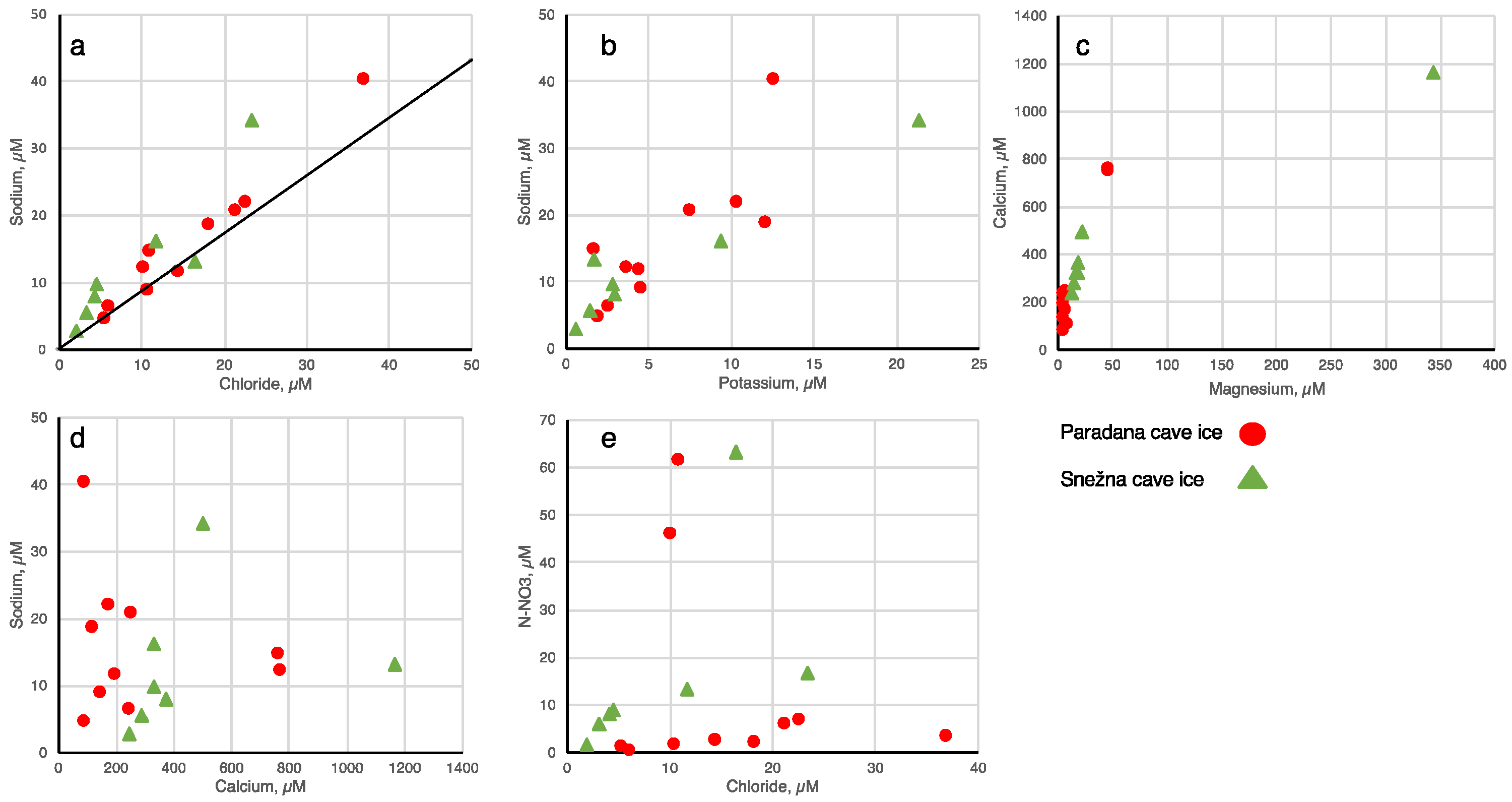
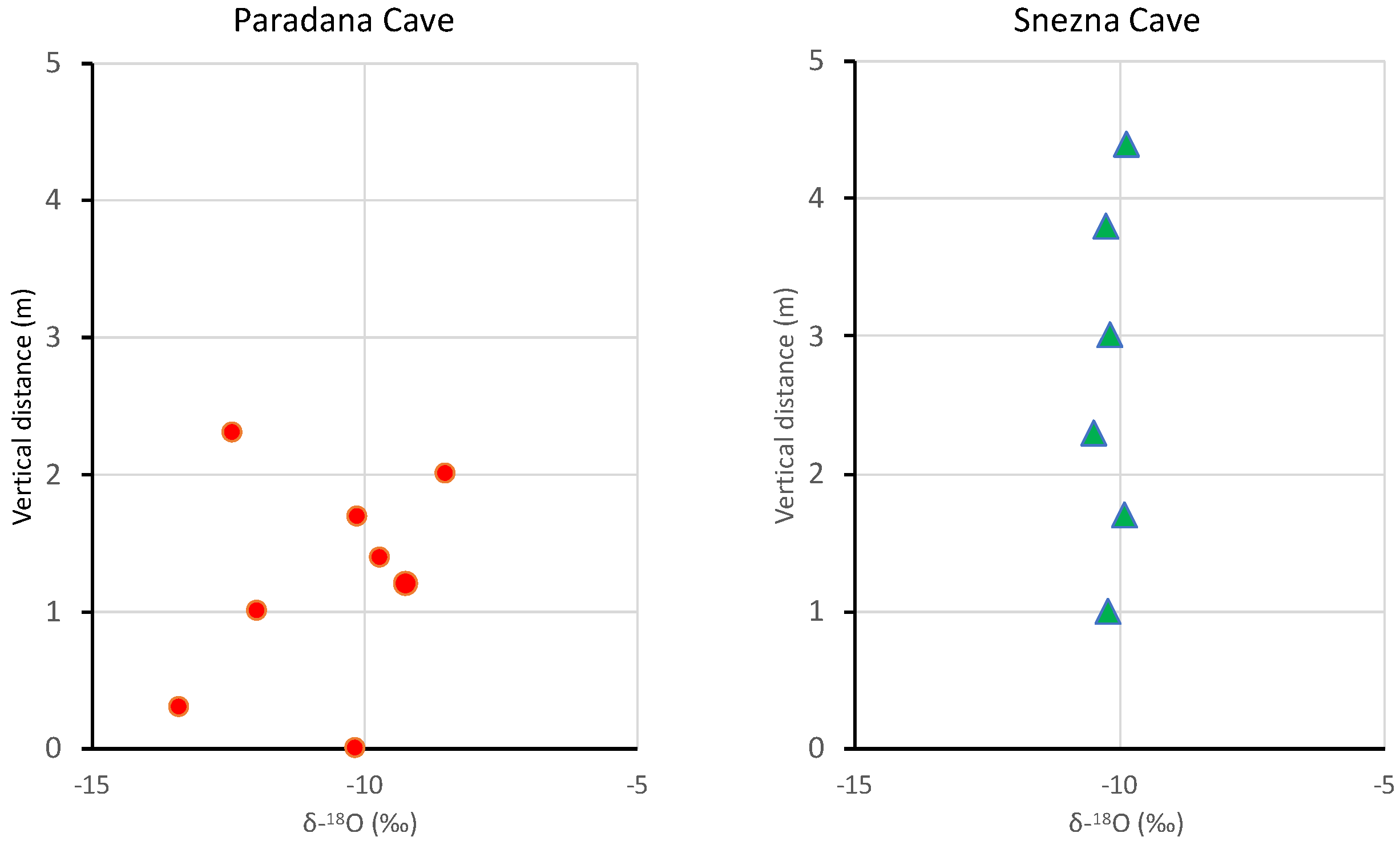
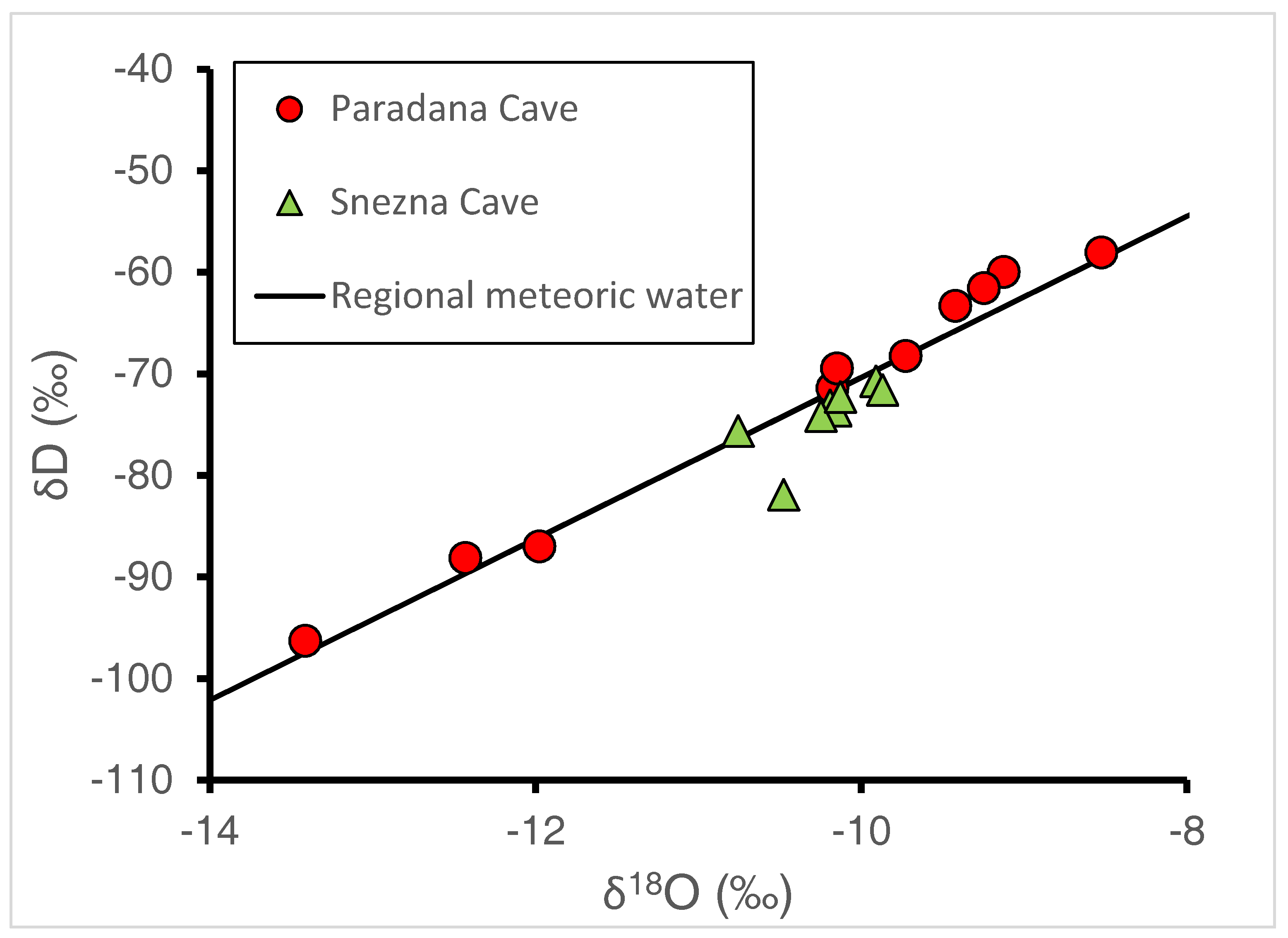
| Paradana Cave | ||||||||||||||||
| Sample Distance From Top of Profile | Cl− | SO42− | SO42− | NO3− | NO3− | NH4+ | NH4+ | Na+ | Na+ | K+ | K+ | Mg2+ | Mg2+ | Ca2+ | Ca2+ | HCO3− |
| 0 m | 6 | 14 | 9 | 1.1 | 19 | 0.9 | 24 | 7 | 5 | 3 | 1 | 6 | 2 | 243 | 8 | 508 |
| 0.3 m | 18 | 11 | 28 | 3.4 | 56 | 4.7 | 73 | 19 | 15 | 12 | 3 | 9 | 7 | 115 | 25 | 239 |
| 1.0 m | 37 | 8 | 58 | 4.6 | 117 | 29.0 | 152 | 40 | 32 | 13 | 6 | 6 | 13 | 87 | 52 | 210 |
| 1.2 m | 21 | 16 | 33 | 7.7 | 66 | 5.5 | 86 | 21 | 18 | 7 | 4 | 7 | 7 | 252 | 29 | 491 |
| 1.4 m | 22 | 16 | 35 | 8.0 | 70 | 14.0 | 90 | 22 | 19 | 10 | 4 | 7 | 8 | 172 | 31 | 343 |
| 1.7 m | 14 | 18 | 22 | 3.9 | 44 | 12.4 | 57 | 12 | 12 | 4 | 2 | 6 | 5 | 15 | 20 | 376 |
| 2.0 m | 5 | 9 | 9 | 2.8 | 17 | 5.0 | 22 | 5 | 5 | 2 | 1 | 5 | 2 | 84 | 8 | 164 |
| 2.3 m | 10 | 16 | 14 | 2.5 | 27 | 17.4 | 35 | 9 | 7 | 5 | 1 | 5 | 3 | 140 | 12 | 275 |
| Floor Melt Water | 10 | 17 | 52 | <1 | 12 | 4 | 46 | 767 | 1545 | |||||||
| Snežna Cave | ||||||||||||||||
| 1.0 | 2 | 10 | 9 | 3.0 | 17 | 0.9 | 22 | 3 | 5 | <1 | 1 | 13 | 2 | 241 | 8 | 487 |
| 2.3 | 3 | 18 | 9 | 8.1 | 17 | 0.4 | 22 | 6 | 5 | 2 | 1 | 15 | 2 | 281 | 8 | 552 |
| 3.1 | 12 | 19 | 19 | 16.8 | 37 | 21.3 | 48 | 16 | 10 | 9 | 2 | 17 | 4 | 325 | 17 | 662 |
| 3.8 | 23 | 25 | 36 | 23.0 | 71 | 45.1 | 92 | 34 | 19 | 21 | 4 | 21 | 8 | 496 | 32 | 1037 |
| 4.4 | 5 | 13 | 9 | 11.4 | 17 | 0.3 | 22 | 10 | 5 | 19 | 1 | 19 | 2 | 326 | 8 | 660 |
| Floor Ice | 4 | 22 | 9 | 10.2 | 17 | 2.6 | 22 | 8 | 5 | 18 | 1 | 18 | 2 | 372 | 8 | 736 |
| Location | Elevation | Mean δ18O, ‰ | Mean d-excess, ‰ |
|---|---|---|---|
| Paradana Cave | 1135 m | −10.7 | 10.7 |
| Snežna Cave | 1514 m | −10.1 | 7.6 |
| Julian Alps * | 2514 m | −11.3 | 14.5 |
| 864 m | −10.6 | 7.5 | |
| 595 m | −8.7 | 7.4 | |
| 740 m | −9.4 | 7.8 | |
| Ljubljana * | 282 m | −8.6 | 9.5 |
| Hubelj Spring | 220 m | −9.7 | 13.4 |
© 2019 by the authors. Licensee MDPI, Basel, Switzerland. This article is an open access article distributed under the terms and conditions of the Creative Commons Attribution (CC BY) license (http://creativecommons.org/licenses/by/4.0/).
Share and Cite
Carey, A.E.; Zorn, M.; Tičar, J.; Lipar, M.; Komac, B.; Welch, S.A.; Smith, D.F.; Lyons, W.B. Glaciochemistry of Cave Ice: Paradana and Snežna Caves, Slovenia. Geosciences 2019, 9, 94. https://doi.org/10.3390/geosciences9020094
Carey AE, Zorn M, Tičar J, Lipar M, Komac B, Welch SA, Smith DF, Lyons WB. Glaciochemistry of Cave Ice: Paradana and Snežna Caves, Slovenia. Geosciences. 2019; 9(2):94. https://doi.org/10.3390/geosciences9020094
Chicago/Turabian StyleCarey, Anne E., Matija Zorn, Jure Tičar, Matej Lipar, Blaž Komac, Susan A. Welch, Devin F. Smith, and William Berry Lyons. 2019. "Glaciochemistry of Cave Ice: Paradana and Snežna Caves, Slovenia" Geosciences 9, no. 2: 94. https://doi.org/10.3390/geosciences9020094
APA StyleCarey, A. E., Zorn, M., Tičar, J., Lipar, M., Komac, B., Welch, S. A., Smith, D. F., & Lyons, W. B. (2019). Glaciochemistry of Cave Ice: Paradana and Snežna Caves, Slovenia. Geosciences, 9(2), 94. https://doi.org/10.3390/geosciences9020094






